De duistere geheimen van het Huis van Bewaring aan de Quai de l’Horloge
In Le monde van 14 juni 2024 publiceerde Modiano-kenner en journalist Denis Cosnard een groot artikel over de opzienbarende resultaten van een archiefonderzoek, titel: Le “dépôt”, prison oubliée de Paris.
Waar was de Joodse Dora Bruder tussen 15 en 19 juni 1942? Dat is een van de vragen waarop Patrick Modiano in zijn aangrijpende roman uit 1996 over dit tot dan toe onbekende slachtoffer van de nazipraktijken het antwoord schuldig moest blijven. Op 15 juni werd het zestienjarige meisje door de wijkpolitie afgeleverd op het adres van haar ouders, 41, Boulevard Ornano, in Parijs; op 19 juni kwam zij aan in het doorgangskamp Les Tourelles bij de Porte des Lilas van waaruit ze via Drancy naar Auschwitz werd gedeporteerd. Misschien, schreef Modiano, is zij in die junidagen overgebracht naar het Huis van bewaring van de Préfecture de police op het Île de la Cité.
Nu, bijna dertig jaar later, blijkt zijn veronderstelling juist te zijn geweest. Tijdens haar onderzoek naar de archieven van de Parijse Préfecture de police ontdekte politiek wetenschapper Johanna Lehr dat daar tijdens de bezetting 11.000 Joden zijn opgebracht vanwege de overtreding van een van de talloze maatregelen die hun dagelijks leven inperkten. Het personeel van deze politiepost in het hart van Parijs was Frans, aan het hoofd stonden twee Franse, rabiaat antisemitische politie-inspecteurs die vloeiend Duits spraken, Jalby en Jürgens. In het nauwkeurig bijgehouden register stonden, behalve de naam van Dora Bruder, ook hun namen en de datum waarop zij werd ondervraagd, 18 juni 1942.
Geen van de Joden die dit Huis van bewaring passeerden, kwam weer op vrije voeten. Ook de namen van de moeder van Georges Perec, Cécile Szulewicz, haar vader Aron en haar zusje Fanny zijn te vinden in dit register; ook zij kwamen in 1943 via deze tot dusverre onbekende omweg terecht in Drancy en later in Auschwitz. Cécile Burdej, de moeder van Dora Bruder, zat in hetzelfde transport (11 februari 1943) als Cyrla Szulewicz.
Zie mijn bespreking : ‘ Dora Bruder van Patrick Modiano’, NRC 20 juni 1997. Autobiografische documentaire van Modiano; De band tussen Parijs toen en nu – NRC Autobiografische documentaire van Modiano; De band tussen Parijs toen en nu – NRC
